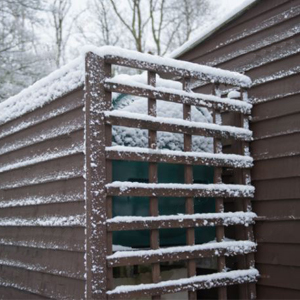Heating oil storage tank maintenance is one element of managing an off-grid fuel source which is quite often overlooked. However, ensuring your fuel tank is serviceable and safe to use is eminently important. Not only could a faulty or damaged tank mean you are left without heat or hot water in your home, but it could also cause serious environmental pollution.
During the autumn season, heating oil customers are encouraged to ‘plan ahead’ and ‘be prepared’ for the start of the bad weather. It is also crucial that you continue this careful management of your oil heating system once the cold weather has started too. Wintery and bad weather can affect your storage tank, so it is essential that you add in extra measures to your usual routine to safe guard your stored fuel during this time.
Below are some of the additional considerations we recommend bearing in mind during the winter season.
1.Securing your oil tank before the weather changes
It is advisable to check that your tank is positioned correctly and securely on its base before there is any bad weather. This means you will have time to reposition the tank and ensure it is safely installed if required.
As the oil level inside the tank decreases the less the tank weights, this means it could be susceptible to moving out of place if there is particularly bad weather such as a strong storm or flooding. If you tank has been displaced it may experience uneven forces on it which over time could lead to damage to the tank itself and has the potential to cause an accidental spill. Keeping your oil level topped up is one way of helping to keep your tank securely in place.
Your heating oil tank should be located centrally on its base. The base itself should be level and even. Signs of damage or subsidence to the base should be assessed and rectified if they are likely to impact on the security of the oil tank.
2.Remove large snow drifts from your storage tank
Your heating oil tank should be inspected each time there is a large snowfall, even if this is out with your usual inspection routine. The weight of a large amount of snow could cause damage to your tank. This excess snow should be carefully removed or brushed off. Lagging any exposed pipework would also be recommended to prevent damage caused by low temperatures or condensation build up in the tank itself.
3.Be vigilant of damage caused by strong winds or storms
It is also good practice to inspect your tank after windy weather or storms, just as you would after a large snowfall. Wind can cause debris such as branches, stones or loose items in your garden (including furniture) to cause damage to your fuel oil storage tank. These items should be cleared from the tank and its surrounding area and the tank should be inspected for any signs of damage. The fittings on the tank should also be checked to make sure they hadn’t become loose and are still water tight.
4.Prevent water contamination from rainwater
During your usual tank inspection we recommend ensuring your heating oil storage tank is waterproofed. This includes checking for any signs of damage or cracks where water could enter your tank, also ensuring lids are closed tightly. In addition to your usual inspection routine it is good practice to check your tank before any bad weather or heavy rain is forecast as an extra measure of protection to prevent water contamination.
If water gets into your stored fuel it can cause bacteria to grow and aid the formation of sludge at the bottom of your tank. Both can cause problems if they enter your fuel lines, where you may need an engineer to clear them and get your heating system up and running again.
5.Check for problems caused by condensation after summer
Condensation is naturally occurring inside your oil storage tank and can be caused by hot weather or weather changes. In some instances condensation can build up and begin to drip into the fuel, causing water contamination of your heating oil. During your regular tank inspections it can be hard to tell if there is water contamination, for this reason it is advisable to check your heating system is working correctly before you want to start relying on it to heat your home during the colder months. This means you will have time to fix any water contamination or heating issues if you have any. Particularly during a summer with sporadic weather or a long period of hot weather this is something to be mindful of.
Regular tank inspections should be carried out every month:
It is recommend that you carry out a regular inspection of your oil storage tank on a monthly basis. This means you have the best chance of spotting the early signs of a fault and can take the necessary remedial action.
A routine tank inspection should include the tank itself, the base and the area around the tank. You should look for any changes since the last inspection or any signs that there has been an oil leak. Find out more about how to inspect your fuel storage tank.
What signs of damage to your tank should you look for?
Damage to your tank can occur for a multitude of reasons; some can be caused by the weather as outlined above, or as the result of an accident or simply due to the age of your tank which will deteriorate over time. Unfortunately plastic fuel tanks cannot be fixed once they have suffered damage and must be replaced.
Whilst inspecting your heating oil storage tank you should be vigilant for: whitening or patches of discolouration; cracks or splits; bowing of the tank; areas of dampness around the pipework or valves or vegetation die-back around the tank. More information on the signs you should look for and pictures can be found here.
